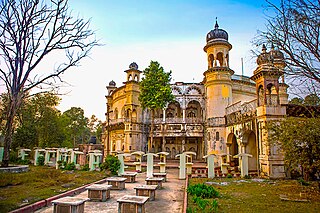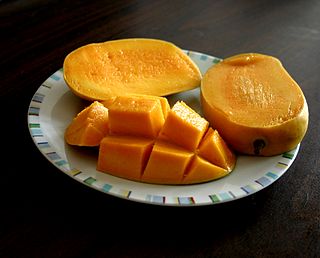Related Research Articles

Rewa is a city in the north-eastern part of Madhya Pradesh state in India. It is the administrative center of Rewa District and Rewa Division. The city lies about 420 kilometres (261 mi) northeast of the state capital Bhopal and 230 kilometres (143 mi) north of the city of Jabalpur. The maximum length of Rewa district is 125 km from east to west and the length of Rewa from north to south is 96 km. This area is surrounded by Kaimur hills to the south Vindhyachal ranges pass through the middle of the district.

Chandauli district is a district of Uttar Pradesh state of India, and Chandauli town is the district headquarters. Chandauli district, a part of Varanasi Division, became a separate district on 20 May 1997.

Banganapalle mangoes is a mango variety produced in Banganapalle of Nandyal District in the Indian state of Andhra Pradesh. It alone occupies 70% percent of total mango cultivable area of the state and was first introduced by the farmers of Banaganapalli. It was registered as one of the geographical indication from Andhra Pradesh on 3 May 2017, under horticultural products by Geographical Indication Registry. It is also grown in the other parts of India and Pakistan. The fruit is described as obliquely oval in shape, around 20cm in length, with yellow flesh and a thin, smooth yellow skin. The flesh is of a firm, meaty texture and is sweet and lacks fibre. The cultivar is the most sought after in Andhra Pradesh. It is a very late-season variety that is good for canning. This cultivar is a source of vitamin A & C and is also called king of Mangoes.

The Himsagar mango is a popular mango cultivar, originating in the modern-day Bangladesh and state of West Bengal in India. Widely considered as the best mango, the inside of Himsagar is yellow to orange in colour and does not have any fibre. The fruit is medium-sized and weighs between 250 and 350 grams, out of which the pulp content is around 77%. It has a good keeping quality. It is also known as Khirsapati.

The 'Gir Kesar' mango, also called Kesar, is a mango cultivar grown in the foothills of Girnar in Gujarat, western India. The mango is known for its bright orange colored pulp and was given the geographical indication status in 2011. The biggest market of Gir Kesar is in Talala Gir known as a Mango Market Yard.
The 'Kari Ishad' mango, is a mango cultivar primarily grown in Ankola and Karwar talukas of Uttara Kannada district, Karnataka, India.
The 'Mankurad' mango, is a mango cultivar primarily grown in the coastal state of Goa, India. It is also cultivated in Vengurla and Malvan talukas of Maharashtra along within Uttara Kannada district of Karnataka. Malcorado, Mancurad, Mankur, Kurad, Corado are variations of the same name. Mankurad varieties include the Cardozo Mancurad, Costa Mancurad, Gawas Mancurad, and Amaral Mancurad.

The Khola chilli is a variety of chilli mainly grown in the Indian state of Goa.
The 'Appemidi' mango, is a mango cultivar primarily grown in Malenadu region of Karnataka, India. Appe midi is the variation of the same name. Appemidi varieties include Ananta Bhattana, Kanchappa, and Karnakundala.
The 'Kuttiattoor' mango or Kuttiattoor Manga, is a mango cultivar primarily grown in the village of Kuttiattoor, Kannur district of Kerala, India. 'Nambiar maanga', 'Kannapuram maanga', 'Kunjimangalam manga' and 'Vadakkumbhagam manga,' are the variations of the same name.
The 'Malihabadi Dusseheri' mango, is a mango cultivar primarily grown in the town of Malihabad, Lucknow district of Uttar Pradesh, India. The Malihabadi Dusseheri mangoes are unique from the Dussehri variety grown elsewhere in India.
The 'Marathwada Kesar mango', is a mango cultivar primarily grown in Marathwada region of Maharashtra, India. Districts where they are primarily grown are Chhatrapati Sambhaji Nagar, Jalna, Beed and Latur.
The 'Rataul' mango, is a mango cultivar primarily grown in Rataul of Baghpat district, Uttar Pradesh, India.
The 'Malda Fazli' mango, is a mango cultivar primarily grown in Malda district, West Bengal, India. It is also known as 'Fazli Babu'.

The Edayur chilli is a variety of chilli mainly grown in the Indian state of Kerala. The Edayur chilli is a local cultivar primarily grown in specific regions of Kerala's Malappuram district. Specifically, it is cultivated in the panchayaths of Edayur, Athavanad, Marakkara, Irimbiliyam, Kalpakanchery, and Valanchery within the Valanchery block, as well as Moorkanad and Kuruva panchayaths within the Angadippuram block.
The Sirarakhong Hathei chilli is a variety of chilli mainly grown in the Indian state of Manipur. It is widely cultivated crop in Sirarakhong village in the Ukhrul district of Manipur.

The Banaras Lal Bharwamirch (Red Pickle Chilli) is a variety of chilli grown in the Indian state of Uttar Pradesh. It is mainly cultivated in Varanasi, Azamgarh, Jaunpur, Ghazipur & Ballia districts of Uttar Pradesh.
Balaghat Chinnor is a variety of non-Basmati aromatic rice mainly grown in the Indian state of Madhya Pradesh. It is a common and widely cultivated crop in tehsils of Balaghat, Baihar, Birsa, Paraswada, Katangi, Waraseoni, Lalbarra, Khairlanji, Lanji and Kirnapur of Balaghat district
Bhandara Chinoor rice is a variety of non-Basmati aromatic rice mainly grown in the Indian state of Maharashtra. It is a common and widely cultivated crop in talukas of Bhandara, Pauni, Tumsar, Mohadi, Sakoli, Lakhani, and Lakhandur of Bhandara district.
Adamchini Chawal is a variety of non-Basmati, traditional, short-grained aromatic rice mainly grown in the Indian state of Uttar Pradesh. It is a common and widely cultivated crop in Chandauli, Mirzapur, Varanasi and Sonebhadra, and Vindhya region of Eastern Uttar Pradesh.
References
- ↑ "MP gets GI tag on nine things including Rewa's Sundarja mango". Free Press Journal. Retrieved 12 October 2024.
- ↑ "From Royal Noor Jahan To Juicy Sunderja, Take A Peek At Bhopal's Magnificent Mango Fest". Free Press Journal. Retrieved 12 October 2024.
- ↑ "MP: Visitors Enjoy Juicy Mangoes At Fest; A Host Of Golden & Green Fruits Shone Like Stars". Free Press Journal. Retrieved 12 October 2024.
- ↑ "NABARD - National Bank For Agriculture And Rural Development". www.nabard.org. Retrieved 12 October 2024.
- ↑ "A Booklet on the Geographical Indications of Madhya Pradesh" (PDF). CII - Intellectual Property. Confederation of Indian Industry. Retrieved 12 October 2024.
- ↑ "Geographical Indications Intellectual Property India". Intellectual Property India. Retrieved 12 October 2024.
